Audio Systems - Basic Principles of a PA System
This article will cover basic Three-Way PA Systems, and look at the differences and functionalities between two-way and three-way PA Systems.
By Marius Van Vuuren
So far we’ve discussed the following:
- How a PA System works, and its intended function.
- Basic Elements on how to connect a PA System and splitting this up as sources, modifiers and destinations.
- Types of PA Systems,
- Full Range Point Source PA System
- Two-Way PA System
This article will cover basic Three-Way PA Systems, and look at the differences and functionalities between two-way and three-way PA Systems.
First and foremost, let’s look at the fundamental key basic differences between a two-way and three-way PA Systems. Again, we make use of basic components (Electronic Crossover and non-DSP based Amplifiers)
The Basic Differences
| Two-Way | Three-Way |
| Makes use of two types of speakers (Separate Bass and Mid-High speakers) | Makes use of three types of speakers (Separate Bass, Mid and High speakers) |
| Makes use of one electronic crossover and two separate amplifiers | Makes use of two electronic crossovers and three separate amplifiers |
| One Crossover Point, to send separate Bass and Mid-High Frequencies to two separate amplifiers | Two Crossover points, to send separate Bass, Mid and High frequencies to three separate amplifiers |
| Typical Crossover point: 12Hz
This means that all frequencies from 120Hz and below will go to the Bass speaker, and frequencies from 120Hz up, will go to the Mid-High speaker |
Typical Crossover points: 120Hz, 1kHz.
This means that frequencies from 120Hz and below will go to the Bass speaker, frequencies between 120Hz to 1kHz will go to the Mid speaker, and frequencies from 1kHz and up will go to the High speaker |
Three-Way PA System
A Three-Way PA System basically works on the same principle as a Two-Way PA system.
The difference is that a Three-Way PA System splits frequencies to different speakers in three ways, instead of two for a Two-Way PA System.
Typically with a Two-Way PA System, frequencies are split between Bass and Mid-Top Speakers, where the Mid-Top speakers are typically full range speakers, meaning there’s two speaker drivers in the same cabinet, that produces Mid and Top frequencies separately, through an internal speaker crossover, whereas with a Three-Way PA System, frequencies are split between separate Bass, Mid and Top speakers.
So essentially, there’s a separate speaker to produce the required frequencies when slit between bass, mid and high frequencies. This allows sound engineers to better control a PA System with frequencies being split over more speakers in a Three-Way PA System as compared to a Two-Way PA System. Three-Way PA Systems tend to have more of a midrange sweet spot when compared to a two-way system, where the mid and high frequencies are produced with a speaker enclosure containing a midrange and high speaker drivers.
So, the active crossover still plays a role in managing and splitting frequencies. With most modern active crossovers, they can be used in either two-way or three-way modes, but in three-way mode, two active crossover units will be needed.
Most modern Amplifiers nowadays include an onboard DSP (Digital Signal Processing), which users can choose a crossover point, amongst other available settings.
Passive Internal Speaker Crossovers
So, to explain how a three-way PA system’s speakers work, let’s look at very basic passive speaker designs to illustrate the differences between two-way and three-way speakers.
Here are two basic examples as used in Hi-Fi/ bookshelf speaker systems.
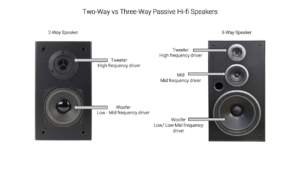
Remember that Hi-Fi/ bookshelf speakers will make use of an internal passive crossover network to distribute frequencies to individual speaker drivers, meaning that the crossover receives its signal from an Amplifier, instead of an Active Crossover sending a signal to a dedicated Amplifier, before it is sent to a dedicated speaker driver.
Internal Passive Speaker Crossovers will have specific specifications for the speaker that it’s in and should also stipulate the crossover frequency points, as there are various crossovers available on the market with specific frequency and power ratings.
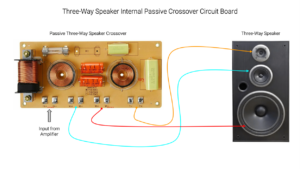
So, a professional Three-way PA system makes use of dedicated speaker drivers within dedicated speaker enclosures, to produce sound within a specific frequency range. The frequencies are set on the active crossover, then sent to a dedicated amplifier, before it is sent to the dedicated speaker.
Below is a diagram illustrating a very basic three-way system configuration, consisting of Bass, Mid and High frequency speakers in separate enclosures, connected to three-way active crossovers and dedicated Bass, Mid and High frequency amplifiers.
Components of a basic three-way PA system could be as follows:
1 x Mixer/ Sound Console
2 x Active Speaker Crossover units (Each set to three-way Mono)
3 x Power Amplifiers
2 x Bass speakers
2 x Mid speakers
2 x High speakers
Audio interconnect cables
Speaker cables
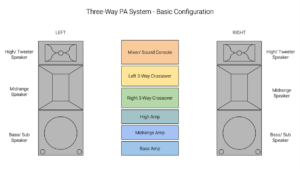
So, let’s look at how to connect this all together, making use of signal and speaker cables.
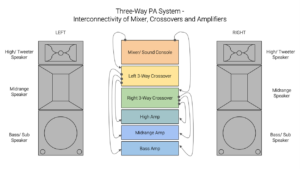
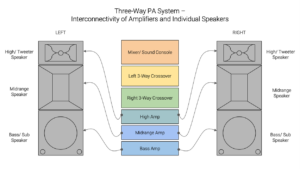
Fine tuning frequencies and volume to each speaker is what is key for the best sound delivery within a specific venue, to get to that “sweet spot”.
Now, designing a three-way PA system is definitely more challenging than two-way systems, because there’s a few factors to consider. For instance, speaker driver specifications (power rating, frequency response and driver size) and amplifier specifications, are key factors to consider.
Bass speakers are typically bigger in diameter and power rating, compared to the mid and high frequency speakers.
Amplifier power for a high frequency speaker will require less power when compared to a bass speaker. Amplifier and speaker ratings are also key, so best make sure that amplifier power ratings match speaker ratings. For instance, a bass speaker will require more power compared to a high speaker or tweeter.
This is where experience and venue acoustics play a big role in deciding the design of a system, suited to the venue, intended use and the type of audience.
Three-way PA systems typically produce a warmer sound quality when compared to a two-way PA system, meaning there’s better control over the mid frequency range.
Depending on what equalization system you use, the mid frequency range is split into low-mid, mid and high-mid frequencies, hence why setting up and tuning a three-way PA system takes patience and a good ear to set it up.
With today’s technology, digital DSP’s (Digital Sound Processor) definitely make it a lot simpler to set up a three-way PA system, but the basic fundamentals of listening to each speaker and what it produces, before listening to the overall system, is what makes the difference.
Too much volume on the bass could potentially drown out the mid and high frequencies, which could drown out a singer’s vocals, so it is very important to fine tune the system so that all individual parts are set optimally to produce an overall good sound quality. Also, too much high frequency volume produced by the high speakers/ tweeters, could cause unnecessary vocal microphone feedback.
Individual three-way speakers that are mounted in separate speaker enclosures typically do not have internal passive crossovers, but in some cases, could make use of a passive filter circuit to only produce certain frequencies. For instance, high frequency driver/ tweeter speakers typically make use of a passive high pass speaker filter and could make use of a filter circuit, to smooth out frequencies being sent to the high frequency driver/ tweeter speaker.
So, What is a High Pass Speaker Filter?
A high-pass filter is an EQ curve that is used to remove low-frequency sounds from an audio signal. It is called a high-pass filter because it allows high-frequency signals to pass through, while attenuating (reducing the amplitude of) lower-frequency signals.
Below is an example of the size of speaker drivers and enclosures that a three-way PA system:
| Driver Size | Driver Design | Enclosure Design |
| 18” | Bass/ Subwoofer driver | Band Pass, Ported, Horn loaded |
| 12” | Mid speaker driver | Horn Loaded, ported |
| 1” | High frequency compression driver | Bolted to a Horn flair |
There are many different types of speaker sizes and enclosure designs available on the market. Speaker driver manufacturers will typically provide data for the optimal enclosure design so that the speaker driver works at its best.
The type of enclosure you want for your speaker drivers will depend on the application, venue size and intended audience.
Quick Recap
So, we’ve learned the following with three-way PA systems:
- The differences between two-way and three-way PA Systems.
- Internal passive speaker crossovers are used to split frequencies to speakers inside an enclosure.
- Three-way PA system set up requires fine tuning to produce an optimal sound quality
- The use and design of a three-way PA system will depend on the intended application, venue size, venue acoustics and the intended audience.
Latest Blog
No results found.....